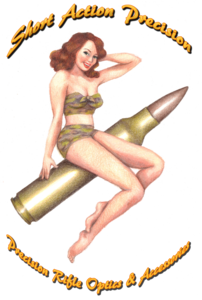Bix'N Andy Trigger Installation Instructions
Pre-Installation Warning & Disclaimer
Short Action Precision nor Bix’n Andy, will accept any responsibility
for any injury, damages, death, loss of property incurred through
the use or mis-use of this trigger. Your well-being and life is important to
us and could be seriously compromised if you do not have this
trigger properly installed. When operating the firearm always
practice safe shooting and only discharge the firearm when it is
pointed in a safe direction. Never install or un-install this trigger
with ammunition in the receiver.
The installation procedure alone can be a very dangerous
activity if you do not ensure that the weapon you are working
on is not unloaded first. When unloading ensure that the muzzle
of the gun is pointed in a safe direction bearing in mind that
a wall should NOT be considered a safe direction to point a
weapon.
It is advisable that you employ the skills of a good gunsmith to
install the trigger. You can do it yourself if you are well versed
with the mechanics of a rifle receiver and the fire control but
consider that this is a premium trigger and to get the most out
of your investment it must be carefully set up.
Installation
These are the four main steps to properly setting up this trigger in order:
1. Installing the trigger into the action correctly.
2. Check the sear engagement.
3. Set the trigger pull weight.
4. Check the firearm for safe operation
As a final step you may need to reset the trigger timing again
to fine-tune accuracy. Please note that over travel is not adjustable.
The trigger has been designed with enough over-travel to
prevent shooting errors.
Installation instructions for Remington styled action
1. Remove bolt, magazine (if any), and any ammo possibly in the rifle.
2. Remove stock
3. Remove pin A from the originally installed trigger
4. Remove pin B from the original trigger (Caution: be sure to not lose the bolt stop spring and bolt stop lever)
5.Remove the original trigger
6. Insert new trigger in its place and fix it with pins A and B (Caution: the bolt catch
spring and bolt catch piece must be installed properly with pin B)
7. Check that the sear engagement is correct:
7.1. Cock the unloaded rifle
7.2. Very carefully turn set screw C clockwise until the firing pin falls.
7.3. Then turn set screw C counter-clockwise 90 degrees or one quarter turn.
7.4. Check the trigger for proper function by cocking the rifle very aggressively - the trigger should be able to hold the firing pin sear every time.
7.5. If you do adjust the bottom-sear engagement and later want the default setting (screw C) simply follow the procedure in 7.2 and 7.3 above. You may need to repeat this exercise several times as the action of torquing the set screw may well set off the trigger.
8. Check the pull weight of the trigger:
8.1. Adjust the trigger pull weight by turning set screw D clockwise to increase pull weight and counter clockwise to decrease pull weight
8.2. Ensure that once the pull weight is set that the rifle still holds the firing pin safely by once again cocking the rifle aggressively.
8.3. Additional springs are provided if you are going to want a heavier trigger pull. The competition trigger comes fitted with the light spring.
9. Install stock using appropriate screws. In some cases a modification may have to be made on the stock to ensure free access of the trigger.
10. Again, check the safe and correct function of the trigger.
Setting Sear Engagement Setting Pull Weight
Light Spring Up to 2.75 oz (Up to 80 gm)
Medium Spring 1.75 oz to 11 oz (50 gm to 300 gm)
Heavy Spring 7 oz to 25 oz (200 gm to 700 gm)
The best way to identify the springs is to measure the wire diameter of
each spring using a calliper. The dimensions are as follows:
Light Spring - 0.0085” (.22mm)
Medium Spring - 0.0175” (.44mm)
Heavy Spring - 0.0215” (.55mm)
Care & Maintenance Instructions
Your trigger should require little to no maintenance with years of use.
However, those in a particularly dusty or dirty environment may feel the need to service the trigger, so here are the guidelines:
1. Find a clean area to work and put down a lint free or microfiber cloth to work on. The following will make your job easier:
• A Phillips screwdriver
• The 1.5mm allen key that the was shipped with the trigger
• Lighter fluid
• Compressed air
2. Remove the Phillips screws.
3. Use the two 1.5mm set screws to jack the cover plate off the trigger housing.
4. It is advisable to turn the jack screws back to their original position immediately as one can forget to do this when replacing the cover plate.
5. Remove the two ball bearings and inspect for any obvious signs of wear.
6. Rinse the trigger mechanism with lighter fluid.
7. Very gently use a stream of compressed air to dry off the trigger.
8. Replace the ball bearings.
9. Replace the cover plate and Phillips screws ensuring that the jack screws are not impeding the seating of the cover plate


